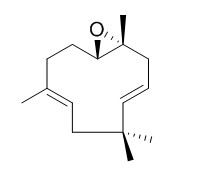Humulene epoxide II
Humulene epoxide II has antimalarial activity.
Inquire / Order:
manager@chemfaces.com
Technical Inquiries:
service@chemfaces.com
Tel:
+86-27-84237783
Fax:
+86-27-84254680
Address:
1 Building, No. 83, CheCheng Rd., Wuhan Economic and Technological Development Zone, Wuhan, Hubei 430056, PRC
Providing storage is as stated on the product vial and the vial is kept tightly sealed, the product can be stored for up to
24 months(2-8C).
Wherever possible, you should prepare and use solutions on the same day. However, if you need to make up stock solutions in advance, we recommend that you store the solution as aliquots in tightly sealed vials at -20C. Generally, these will be useable for up to two weeks. Before use, and prior to opening the vial we recommend that you allow your product to equilibrate to room temperature for at least 1 hour.
Need more advice on solubility, usage and handling? Please email to: service@chemfaces.com
The packaging of the product may have turned upside down during transportation, resulting in the natural compounds adhering to the neck or cap of the vial. take the vial out of its packaging and gently shake to let the compounds fall to the bottom of the vial. for liquid products, centrifuge at 200-500 RPM to gather the liquid at the bottom of the vial. try to avoid loss or contamination during handling.
J Food Sci Technol.2022, 59(1):212-219.
Molecular & Cellular Toxicology2017, 13(3):271-278
Food Science and Biotechnology2015, 2205-2212
Planta Medica International2022, 9(01):e108-e115.
The University of Manitoba2021, 35690.
J Sep Sci.2018, 41(9):1938-1946
Biomed Pharmacother.2024, 175:116770.
Molecules.2015, 20(10):19172-88
Biol Pharm Bull.2020, 43(10):1534-1541.
Antioxidants (Basel).2023, 12(12):2078.
Related and Featured Products
Nat Prod Res. 2015;29(9):883-6.
Composition and antioxidant activity of Senecio nudicaulis Wall. ex DC. (Asteraceae): a medicinal plant growing wild in Himachal Pradesh, India.[Pubmed:
25515495]
METHODS AND RESULTS:
The composition of essential oil isolated from Senecio nudicaulis Wall. ex DC. growing wild in Himachal Pradesh, India, was analysed, for the first time, by capillary gas chromatography (GC) and GC-mass spectrometry.
A total of 30 components representing 95.3% of the total oil were identified. The essential oil was characterised by a high content of oxygenated sesquiterpenes (54.97%) with caryophyllene oxide (24.99%) as the major component. Other significant constituents were Humulene epoxide II (21.25%), α-humulene (18.75%), β-caryophyllene (9.67%), epi-α-cadinol (2.90%), epi-α-muurolol (2.03%), β-cedrene (1.76%), longiborneol (1.76%), 1-tridecene (1.16%) and citronellol (1.13%). The oil was screened for antioxidant activity using DPPH, ABTS and nitric oxide-scavenging assay.
CONCLUSIONS:
The oil was found to exhibit significant antioxidant activity by scavenging DPPH, ABTS and nitric oxide radicals with IC50 values of 10.61 ± 0.14 μg mL(- 1), 11.85 ± 0.28 μg mL(- 1) and 11.29 ± 0.42 μg mL(- 1), respectively.
Molecules. 2015 May 4;20(5):7990-9.
Chemical Composition and Insecticidal Activity of Essential Oils from Zanthoxylum dissitum Leaves and Roots against Three Species of Storage Pests.[Pubmed:
25946557]
This work aimed to investigate chemical composition of essential oils obtained from Zanthoxylum dissitum leaves and roots and their insecticidal activities against several stored product pests, namely the cigarette beetle (Lasioderma serricorne), red flour beetle (Tribolium castaneum) and black carpet beetle (Attagenus piceus).
METHODS AND RESULTS:
The analysis by GC-MS of the essential oils allowed the identification of 28 and 22 components, respectively. It was found that sesquiterpenoids comprised a fairly high portion of the two essential oils, with percentages of 74.0% and 80.9% in the leaves and roots, respectively. The main constituents identified in the essential oil of Z. dissitum leaves were δ-cadinol (12.8%), caryophyllene (12.7%), β-cubebene (7.9%), 4-terpineol (7.5%) and germacrene D-4-ol (5.7%), while Humulene epoxide II (29.4%), caryophyllene oxide (24.0%), diepicedrene-1-oxide (10.7%) and Z,Z,Z-1,5,9,9-tetramethyl-1,4,7-cycloundecatriene (8.7%) were the major components in the essential oil of Z. dissitum roots.
CONCLUSIONS:
The insecticidal activity results indicated that the essential oil of Z. dissitum roots exhibited moderate contact toxicity against three species of storage pests, L. serricorne,T. castaneum and A. piceus, with LD50 values of 13.8, 43.7 and 96.8 µg/adult, respectively.
Pharm. Biol., 2004, 42(2):94-7.
Chemical Constituents and Preliminary Antimalarial Activity of Humiria balsamifera.[Reference:
WebLink]
METHODS AND RESULTS:
From stems and leaves of Humiria balsamifera St. (Aubl.) Hill (Humiriaceae) were isolated 6 triterpenes [arjunolic acid, 2β,3α-dihydroxy-D:A-friedooleanane, friedelin, α- and β-amyrins and lupeol], a flavonol (quercetin), an isocoumarin (bergenin) a diterpene (phytol), and 2 phytosteroids (sitosterol and stigmasterol)]. Three sesquiterpenoids [caryophyllene oxide (0.9%), Humulene epoxide II (0.3%) and trans-isolongifolenone (0.6%)], a diterpene [phytol (29.4%)] and four aliphatic esters [methyl tetra- (0.3%), hexa- (26.6%) and octadecanoate (0.3%), and ethyl tetradecanoate (26.9%)] were identified by GC/MS. Some crude extracts, arjunolic acid and bergenin, were screened in vivo and/or in vitro for their antimalarial activities against a chloroquine resistant strain. Structures of all isolated compounds were elucidated by spectroscopic analysis, including 2D NMR experiments.
CONCLUSIONS:
All isolates, with the exception of the isocoumarin bergenin, and identified compounds as well as antimalarial activities, are described for the first time for this species.



